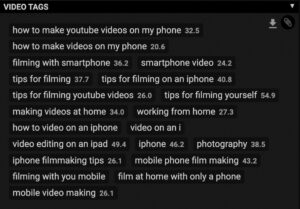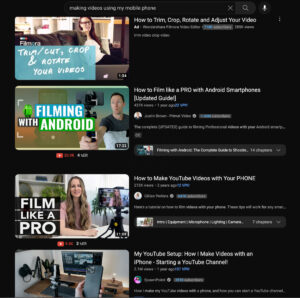
Beginner Read Digital Strategy
An effective digital strategy can be vital to your organisation’s success. Read on to understand the key considerations when developing yours.
In this article

Studio artist Georgina Towler in her studio at Contains Art; Onion Collective; Photo © Jesse Roth
You may be familiar with the importance of keywords in relation to your website copy and search engine optimisation, but did you know that video platforms also use keywords to prioritise different content? Like the Google Search Engine, YouTube and Instagram use many different metrics to measure the relevance of search results based on what the user is searching for. One of those metrics is Keywords.
Don’t know what a keyword is? Don’t worry we’ve got you covered. What is a keyword?
Keywords are an essential element of your video’s description or caption on these platforms, as they help the algorithms understand the content of your videos and make them more discoverable to viewers. By including relevant keywords in your video description or captions, you can improve your chances of appearing in search results and recommended videos, which can help increase your views and engagement.
In this article, we’ll explore how to choose keywords that will get your videos noticed by as wide an audience as possible.
YouTube is one of the most popular video streaming platforms in the world, and it is no surprise that many creative and cultural organisations and individuals are looking to take advantage of its potential for their own benefit. Creating content for YouTube, however, is not as simple as just uploading a video and hoping for the best.
When choosing keywords for your YouTube videos, it is important to consider what words and phrases viewers are likely to use when searching for content like yours. You can use tools such as the YouTube Keyword Tool or Google’s Keyword Planner to help you identify popular keywords and phrases that are relevant to your videos. It is also an innovative idea to include a mix of broad and specific keywords in your descriptions, as this can help ensure that your videos are discoverable by a wider range of viewers.
Here is an insert example of one of our own videos on Mobile Phone Filmmaking.

In addition to helping your videos rank higher in search results, keywords can also be useful for organising your videos and making them easier for viewers to find. For example, you could use keywords to create playlists of related videos, or to group your videos into various categories. This can help viewers find the content they are interested in more easily and can also help improve the overall user experience on your channel.
Using a very generic keyword search term such as “Mobile Phone Video” could generate vastly different types of videos on Mobile Phone Video. These kinds of search keywords are more of a lucky dip than anything targeted and therefore will struggle to be discovered. This type of search reveals a 50% success rate.

Simply giving YouTube a little more help with what we are searching yields better results. Therefore we need to keep this in mind when we are tagging, describing, and titling our videos on YouTube so that we ensure that our content is not only categorised in the right places, but is also discoverable when YouTube relies on Keywords with no historical data to help.

To recap the process, it’s essential to include keywords in your YouTube video descriptions to make your content more discoverable to viewers. By choosing the right keywords and using them effectively in your descriptions, you can improve the visibility and reach of your videos on YouTube. There are several ways to take advantage of YouTube’s algorithms to improve the visibility and reach of your videos. Some of these strategies include:
Overall, the key to taking advantage of YouTube’s algorithms is to create high-quality content that is relevant, engaging, and consistent, and to actively engage with your audience.
If you’re scratching your head, stumped for which keywords and hashtags to include then don’t panic. There are several tools and websites that can help with this, such as keyword research tools, social media management tools, and hashtags search engines. These tools can provide insights on popular keywords and hashtags within a particular industry or niche, as well as help users find relevant hashtags to use on their own content. It is important to do some research and compare different tools to find the ones that best meet your needs.
Vid IQ has been my go-to tool when it comes to addressing the needs of my YouTube video’s descriptions, tags, and even thumbnails. Through small incremental steps, I have been able to increase my clicks and through careful planning of my video structure, I have been able to increase watch time. This all adds up and will mean the YouTube algorithm will push your content further afield to more people.
Instagram is another fantastic platform for video content where videos can be enjoyed by a far wider audience when you use the correct hashtags in your caption. Videos are a really popular form of content on Instagram, allowing users to share short clips with their followers. Instagram has a number of tools and features specifically designed for creating and sharing videos, including the ability to trim and edit videos, as well as add filters and other effects.
Hashtags are a popular feature on the social media platform, allowing users to easily search for and discover content related to specific topics. Hashtags can be a useful tool for increasing the reach and visibility of videos on Instagram. By including relevant hashtags in the caption or comments of a video post, users can make their content more discoverable to others. This can help to increase engagement and attract more views, likes, and comments on the video. #DiscoverableContent
It is important to use hashtags wisely and not overuse them, as this can come across as spammy and may decrease engagement. A good rule of thumb is to use a mix of popular, relevant hashtags, as well as more niche or specific hashtags that are related to the content of the video.
Instagram also offers a few features specifically for video content, such as the ability to add music to videos, or create short, looping videos using the Boomerang app. These can help to make videos more engaging and visually appealing and can help to attract more views and engagement.
In conclusion, hashtags and videos are two powerful features on Instagram that can help users to increase the reach and visibility of their content. By using hashtags wisely and taking advantage of the tools and features available for creating and sharing videos, users can engage with a wider audience and increase engagement on their posts Here are some popular tools to find hashtags on Instagram:
These tools could help you find hashtags that are relevant to your niche and increase the visibility of your posts on Instagram.
The Digital Culture Network is here to support you or your organisation. Our Tech Champions can provide free 1-2-1 support to all creative and cultural individuals and organisations who are in receipt of, or eligible for, Arts Council England funding. If you need help or would like to chat with us about any of the advice we have covered above, please get in touch. Sign up to our newsletter below and follow us on Twitter @ace_dcn and LinkedIn for the latest updates.
Beginner Read Digital Strategy
An effective digital strategy can be vital to your organisation’s success. Read on to understand the key considerations when developing yours.
Beginner Read Email Marketing
Email marketing is a powerful tool when it comes to building relationships with your audience. Read on to find out more about what it can do for your organisation.
Beginner Read Video and Digital Content
Storytelling is the key to amazing content. Read on to understand how to incorporate great content into all facets of your digital marketing.
Beginner Read Video and Digital Content
Storytelling is the key to amazing content. Read on to understand how to incorporate great content into all facets of your digital marketing.
Beginner Read Video and Digital Content
Here are five things to bear in mind when making your next video.
Beginner Read Video and Digital Content
Looking for ways to make your content work harder for you? Our checklist will help you create more engaging material for your target audience.



